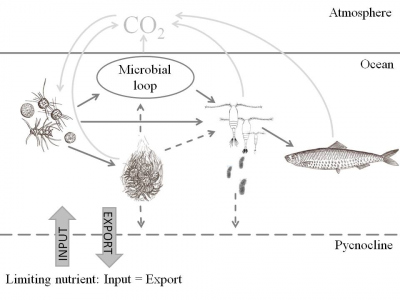Seitenpfad:
- Startseite
- Morten Iversen
- What is organic matter in the ocean?
What is organic matter in the ocean?
When carbon dioxide (CO2) is fixated and turned into organic material during photosynthesis by phytoplankton, the carbon is converted from dissolved inorganic to particulate organic carbon. This transformation enables downward transport of carbon, since particles can sink in the ocean, whereas solutes cannot (Kiørboe 2001). On short time scales, the amount of vertically transported material is controlled by the sinking speeds and degradation rates of settling particles. On long time scales the vertical flux is balanced by the input of limiting nutrients to the sunlit areas of the ocean (euphotic zone) since export cannot exceed input. In this perspective the pelagic degradation mainly influences the magnitude of recycling and, thus, the size and structure of the pelagic biomass (Kiørboe 2001) (Fig. 1).

Fig. 1. Simplified pelagic ecosystem. Limiting nutrient are entering the euphotic zone from the aphotic zone and taken up together with CO2 by growing phytoplankton. Vertical flux occurs via sedimentation of aggregation of phytoplankton and zooplankton fecal pellets. At steady state the sinking aggregates balance the nutrient input rate. Thus, the sum of both marine snow and fecal pellets must balance the nutrient input, meaning the more marine snow contribute to settling the less is the ´need´ for zooplankton to the flux, resulting in lower zooplankton biomass. However, remineralization of both aggregates and phytoplankton also occurs via the microbial loop and grazing. Remineralization retains the material in the upper ocean, governing increased aggregate formation or zooplankton biomass, if steady state between input and export of limiting nutrients are maintained. This increased biomass can benefit higher trophic levels as well. If remineralization of the sinking aggregates occurs below the euphotic zone, the net burial rate of carbon in the deep ocean is reduced. (The figure is modified from Kiørboe (2001)).


